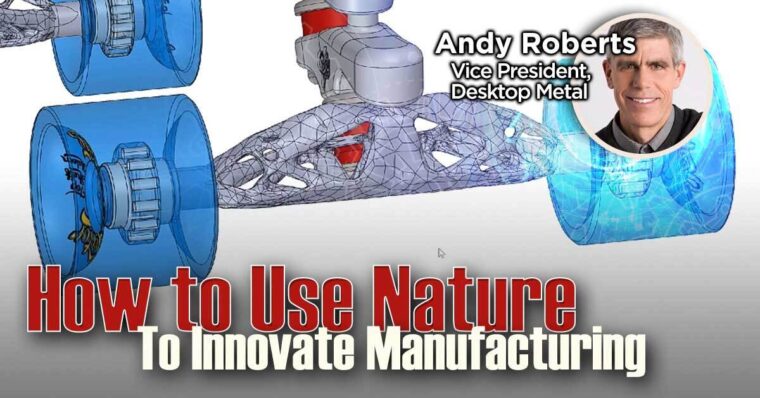This week’s show is a follow up of a recent episode we did about 3D printing. A lot of the listeners were interested in learning more about the overall tools and techniques of 3D printing. Andy Roberts, Vice President, inventor, and lead developer of Live Parts™ at Desktop Metal, joins us to discuss 3D printing and how they seek to innovate manufacturing processes.

Background
Andy Roberts was in the software industry for many years before getting involved with 3D printing. Eventually, he wanted to be involved in something more tangible, like manufacturing. When Desktop Metal started, he saw an opportunity to innovate manufacturing by mixing software with hardware through 3D printing technology.
I have a little background in subtractive manufacturing, or building by removing material. My father worked at an old milling machine company. I find additive manufacturing, or construction by adding material, very interesting.
The technology allows parts to be made in ways that they weren’t able to be made before. The creation of finished or near-finished products makes the technology quite sophisticated. Desktop Metal is building printers for the creation of products, as well as the software for people to use them properly. Good software is essential. If a user is not from a manufacturing background, the software will still allow them to create quality parts.
Live PartsTM
Andy was interested in innovating manufacturing by creating new design tools for engineers. One day, he was looking out a window and watching trees blow in the wind. Thinking about nature, he asked how no one designs a tree. One plants a seed, then it grows and adapts on its own. Andy started studying cells and how individual cells grow and take the form of different shapes. He created a prototype design tool based on this process.
While it seemed like a cool idea twelve years ago, the technology was not there, so Andy put it on the shelf and pursued other ventures. Desktop Metal started four years later. He reached out to them to help build this software through 3D printing. The process begins with an assembly of existing parts. You then designate the regions that have to connect to different parts and send the information to the system. You need to specify the material which defines the strength of the parts. The system knows to get rid of excess material for less weight or to add material for more strength.
Innovating Manufacturing Processes
Andy walked us through a video showing the process of a skateboard being created by Live PartsTM. The parts were shown growing to fill in the regions connecting the pieces. Next, they went through a process of adapting, in which old cells were killed off, and new cells were spawned. The analysis of the part simultaneously takes place as the part grows, similarly to what happens in nature.
When it comes to different materials, the parts can be very different. Engineers have the opportunity to choose different materials and change them during the process based on their wants. The parts react just like living cells and adapt accordingly, which is how Live PartsTM has innovated manufacturing through 3D printing.
Advice for the Listeners
In the innovator space, there is a lot of interest in rapid prototyping to get ideas tangible. Many innovators have the ideas but don’t have a mechanical background or any experience with 3D printing. Andy recommends that innovators get their feet wet with 3D printing in some capacity. If you work for an organization that has access to printing materials such as plastic or polymer, start using them.
Learn about the benefits and drawbacks of using 3D printing technologies. A common misconception is that you push a button and it starts printing things. There are a lot of details and constraints that will affect your design when you are attempting to innovate manufacturing. Involvement in not about buying a 3D printer. There are a lot of places that have access to 3D printers so you can get started.
About our Guest: Andy Roberts
Andy Roberts is Vice President, inventor and lead developer of Live Parts™, a new generative design tool at Desktop Metal. The tool uses morphogenetic principles to enable engineers and designers to quickly realize the benefits of additive manufacturing, including material and cost efficiency, and design flexibility. A graduate of Harvard University and Massachusetts Institute of Technology with extensive experience at leading technology innovators such as Parametric Technology Corp., Ab Initio, Azuki Systems, and IBM, Andy has a proven track record of bringing to market successful products for engineers and developers.
If you want to keep updated with what Andy is doing with Live Parts, check out Desktop Metal’s website here.
To know more about 3D printing and using nature to innovate manufacturing, listen to this week's show: How to Use Nature to Innovate Manufacturing.
Subscribe: RSS


Please note: I reserve the right to delete comments that are offensive or off-topic.